Vanguard Models
 |
Vanguard Models is in 2019 opgericht door Chris Watton, een ontwerper van modelschepen, wiens werk bekend is in deze hobby. Hij werd vooral bekend van zijn werk met bedrijven als Amati. |
| Naam | Omschrijving | Afbeelding |
|---|---|---|
| Erycina – Plymouth Trawler | Erycina – 1882 Erycina was originally built as a cutter. She was designed by H.V. Prigg and built by W.H. Shilston, Coxside, Sutton Harbour in 1882. She was converted to a ketch rig in 1894. Due to her pedigree, Erycina has unusually beautiful lines, described as a ‘Crack Ketch’, and handled more like a racing yacht than a fishing vessel. Erycina fished along the South West UK coast for over 50 years, an incredibly long career for such a vessel. Her overall length was 71 feet, with a length between perpendiculars of 63 feet. The moulded bredth of 17 foot 2 inches was rather more fine than that of the average trawler, but she was built for speed, and of- ten raced at regattas with with the crack Brixham Smack, Ibex. In 22 races at Plymouth regattas, Erycina won 15 first, 4 second and 2 third prizes. The kit Our lovely Erycina kit incorporates the very latest in design techniques, yet is suitable for the total beginner, as well as the seasoned modeller who wants to create something a little different and go to new lengths. To help capture the very fine hull lines, this kit has no less than 16 bulkheads that slot into its keel. Even though this kit is primarily aimed at beginners, it has no less detail in terms of scale. This is a fully-featured model kit. The laser-engraved deck is made from maple ply. Walnut dowel is provided for masts etc. We anticipate Erycina will take around 100-150, as a very average estimate. Scale – 1:64 Length Overall – 524mm Height Overall – 380mm Width Overall – 90mm | 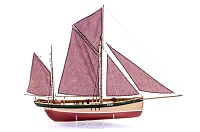 |
| Fifie ‘Lady Eleanor’ | The Fifie was a very attractive and numerous fishing boat that was commonly seen around the waters off the east coast of Scotland from around 1850, and in operation for around a century. These were very popular and successful vessels and real workhorses for those Scottish fishing communities, particularly in landing herring. Unlike the Zulu (Vanguard Models kit #03), the Fifie had more of a traditional layout, with no steeply raked sternpost, and she was almost symmetrical in side view, with quite a wide beam for a relatively short vessel. The model kit is designed to be as accurate as possible for a commercial kit in both scale and detail and has been developed with the beginner to intermediate modeller in mind, with some aspects simplified for ease of construction. More experienced modellers can modify the kit how they wish. This kit is an ideal introduction to the world of Plank on Bulkhead (POB) modelling, and the modeller will learn many valuable lessons through its construction. Scale 1:64 Dimensions: Length: 380mm Width: 105mm Height: 327mm | 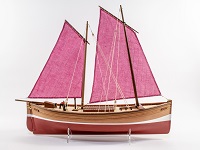 |
| HMS Sphinx – 1775 | This is Vanguard Models’ latest kit release. This is our most comprehensive design to date, incorporating a vast number of pre-cut and engraved parts spread over 33 sheets of mainly pear wood, with high grade MDF used for the skeleton. The laser-engraved decks are made from maple ply, and we also include ply decks for the forecastle and quarterdeck, in case you want to plank those yourself (planking material not provided for that option). Walnut dowel is provided for masts and yards. It is anticipated that this model, designed for intermediate modellers upwards, will take around 400-800hrs, as a very average estimate. Scale – 1:64 Length Overall – 797mm Hull Length – 604mm Height Overall – 627mm Width Overall – 332mm | 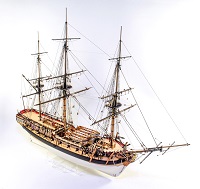 |
| Nisha – Brixham ‘Mumble Bee’ | The ‘Mumble Bee’ was cutter rigged, full bowed and broad beamed. They were strongly built and many survived to a good old age. Because of their fine lines, a few of these vessels were converted to yachts in their later life. Those fishing off the Welsh coast out of Tenby, working the fishing grounds in Mumbles Bay, acquired the collective term ‘Mumble-Bees’. In part, this was coined because of the large numbers of them ‘buzzing’ around the Mumbles like bees around a hive, and also arose by them adopting some of the features of the established Mumbles boats. Nisha had an overall length of 59 feet 3 inches, moulded beam of of 14 feet. She had a deep drag aft with a draft of 7 foot 10 inches but only 4 feet forward. Her fine lines translate into a very pleasing hull shape, making a very attractive display model. The kit Our lovely little Nisha incorporates the very latest in design techniques, yet is suitable for the total beginner, as well as the seasoned modeller who wants to create something a little different and go to new lengths. Even though this kit is primarily aimed at beginners, it has no less detail in terms of scale. This is a fully-featured model kit. The laser-engraved deck is made from maple ply. Walnut dowel is provided for masts etc. We anticipate Nisha will take around 100-150 hours to complete, as a very average estimate. Scale – 1:64 Length Overall – 387mm Height Overall – 311mm Width Overall – 74mm | 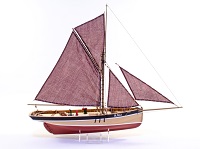 |
| Royal Yacht, Duchess of Kingston – 1778 | History: The royal yacht built for The Duchess of Kingston was built by the shipbuilders JM Hillhouse of Bristol in the late 1770’s. This type of vessel seemed to retain many older, more classical features, compared to those built for the Royal Navy, making the yacht look more a product of the late 17th/early 18th Century. The dimensions on the original plans are as follows: Keel length – 68 Feet Range of deck length – 81 Feet Moulded Breadth – 24 Feet Depth of hold under beams – 10 Feet Burthen in tons – 206 This kit depicts the royal yacht built for The Duchess of Kingston (1778) Scale – 1:64 Length Overall – 576mm Height Overall – 480mm Width Overall – 208mm | 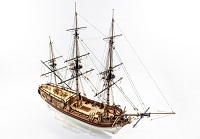 |
| Saucy Jack – Barking Well-Smack | Well smacks were smacks built with an integral circulating sea-water tank in which the fish could be kept alive for some days. By 1830 there were 30-40 well smacks, or “fish pools” as they were called, working out of Barking. Most well smacks were around 50-60 feet long and carried a crew of 7 or 8. The smack ‘Saucy Jack’ was a typical example of this type of vessel. She was built at Gravesend in 1836, and was 60ft overall and weighed 51 tons. The Saucy Jack served many years and was the last well smack to leave Barking, in 1880, although well smacks continued to be used for a very long time after that in other ports. Some vessels built later on in the nineteenth century were still fishing at Faroe in the 1950’s. Although using the well to keep the fish was a better method than salting and wind drying, it had several drawbacks. Well smacks were not very fast due to the effect of carrying several tons of sea-water within the hull. The extra scantlings required and the manufacture of the well itself resulted in a significant increase in the cost of the vessels themselves. The kit Scale – 1:64 Length Overall – 425mm Height Overall – 361mm Width Overall – 86mm | 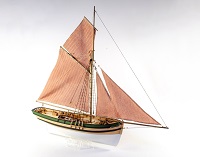 |
| Ship’s Boats (various types) | We are pleased to be able to offer you a varied and expanding range of 1:64 ship’s boats, as standalone kits. All of these, whilst built around a disposable MDF frame, are made from high grade pear wood, and incorporate laser-cut plank strips, and photo etch parts, such as oarlocks*, boat hooks* and anchors*. An option is also provided for the modeller to use either pear wood or photo-etch oars. (*depending upon boat type) Dimensions (Length, without rudder) 18ft Cutter – 86mm 20ft Cutter – 95.25mm 22ft Cutter – 104.8mm 24ft Cutter – 114.3mm 25ft Cutter – 119mm 22ft Yawl – 107mm 24ft Launch – 114mm 26ft Launch – 125mm 28ft Pinnace – 134mm 32ft Barge – 151mm 32ft Pinnace – 151mm 34ft Launch – 162mm 36ft Admiral’s Barge – 165mm | 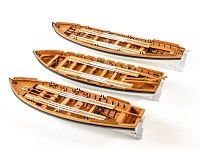 |
| HMS Alert – 1777 | HISTORY The Alert, built in Dover by Henry Ladd and launched on 24th June 1777, was the largest class of cutter in the Royal Navy. Alert originally carried ten four-pounder carriage guns and six to twelve half-pounder swivel guns. She was one of fifteen cutters built for the Royal navy between 1777 and 1778. Smaller cutters were often purchased or built by private yards and then purchased by the Navy, but Alert was purpose built from the keel up. In February 1778, Alert docked at Plymouth for an overhaul, to which some alterations were made to her hull and the ten four pounder carriage guns were replaced with twelve six pounder guns, raising her broadside weight by 30%. The guns were changed because six-pounder shot was more commonly available and, of course, they were more effective. Because of the increase in ordnance, the crew of the Alert was increased from sixty to eighty men, and recommissioned under a new commander, Lieutenant William George Fairfax. In May 1778, Fairfax was promoted to Commander and Alert was re-classed as a sloop to comply with Admiralty requirements. (Although always remained cutter rigged) On 17th June 1778, the Alert, in company with the frigate Arethusa, spotted and intercepted the French frigate Belle Poule and the armed lugger Coureur, with the latter overhauled by the Alert and surrendered, returning to Spithead after the action with her prize. On 8th July of the same year, whilst on an independent deployment, searching for the enemy fleet, Alert was taken by surprise and captured by the French frigate Junon. Alert is reported as lost without trace on 15th December 1779. his is a newly reworked edition of this kit (V3), and the only one we now produce. Our revised Alert kit is now supplied with a complete set of sails. Scale 1:64 Dimensions of the model: length 63.7cm height 51.7cm width 25.6cm The model kit of the Alert is depicted after her refit with twelve six-pounder guns and a full compliment of twelve half-pounder swivel guns, giving an ordnance total of twenty four guns. The model kit is designed to be as accurate as is possible for a commercial kit in both scale and detail. To this end, all hull and deck fittings are bespoke with no ‘off the shelf’ fittings used. Although the kit of Alert is as easy to build as we can make it, very basic woodworking skills (and patience) are still required. | 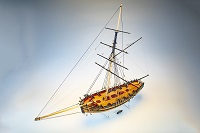 |
| HMS Flirt | Standard Edition Scale – 1:64 Length Overall – 656mm Height Overall – 492mm Width Overall – 230mm Master Shipwright Edition Scale – 1:64 Length Overall – 656mm Height Overall – 492mm Width Overall – 230mm | 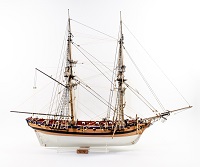 |
| HMS Speedy | History This small brig was the one of the first generations of new naval brigs, and her lines were more of a hybrid between a sleek cutter and brig. She was a small vessel for her class, but what she lacked in size and raw gunpower, she more than made up for in character. Speedy had a very active history, being captured in 1794 by French frigates and then recaptured in March the following year. After Cochrane lost her (in an unwinnable battle), Speedy was renamed Saint Pierre and presented to the pope by Napoleon himself. It is while commanding Speedy that Cochrane made his name. This was his first command, and the combination of this aggressive commander and Speedy ensured that they would be a thorn in the side of the French and Spanish navies, culminating in the remarkable exploit of taking the Spanish 32-gun frigate Gamo (with xebec hull and rig form). Cochrane led 48 of his crew (almost all of them) up the sides of the frigate, which had over 300 men and eventually took the ship. This is now the standard edition of the Speedy kit, which now comes with pearwood laser cut parts and pearwood planking. All laser cutting is now done in-house. Dimensions of completed model are: Length – 700mm ( 27.5 “) Width – 230mm ( 9.0″) Height – 492mm ( 19.4″) The 1:64th scale kit has been extensively researched and has been developed to show her as she would have likely looked in 1800/01, when commanded by Thomas Cochrane. For the modellers who like to add detail over and above what kits offer, the Speedy kit does include the lower deck, which is stepped aft and at the correct height to the main deck. There are a lot more bulkheads than standard kits of this size to help keep the very fine hull lines when planking. | 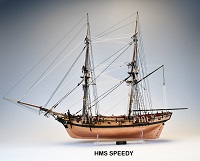 |
| Zulu ‘Lady Isabella’ | HISTORY The Zulu was an innovative hybrid which fused the extreme rake of the sternpost of the ‘Scaffie’ and the near straight stem of the ‘Fifie’. This produced a unique and highly successful class of fore and aft rigged fishing vessels during the last decades of the herring sail fishery. Tillers gave way to the steering wheel, operated via a worm screw gear system. The sail area was large for the size of vessel, and the Zulu’s could reach 10 knots with little problem, and it is of this pinnacle of Zulu development that the Lady Isabella is based upon. Interestingly, the Zulu had no standing rigging on its fore and aft masts, instead relying on support entirely upon their sail halyards and a burton stay tackle, set up to windward. This did mean that any failure would have been catastrophic. THE KIT – Scale 1:64 Just because a kit is primarily aimed at a beginner, doesn’t mean we want to compromise on the quality of materials included. This kit features premium features, yet is highly prefabricated so that the modeller stands the very best chance of a successful completed build. Dimensions of completed model are: Length – 600mm ( 23.6 “) Width – 100mm ( 3.9″) Height – 387mm ( 15.2”) The 1:64th scale kit has been extensively researched with the aid of an expert in this type of vessel, and has been designed to show her as she would have likely looked in the heyday of Scottish herring fishing off the east coast of Scotland. This is a highly authentic model, incorporating details such as the steam winch, fish hatches and companionway, steering unit and full rigging. Rigging, however, is simple and suitable for a beginner. The kit has the following features: 9 sheets of laser cut materials, including a laser cut and engraved deck 1 photo etched sheet in brass Double planking in limewood and second planking in pear wood Walnut dowel for masts and yards 2 separate rigging thread sizes in black and natural 36-page full colour building manual and 7 sheets of 50x70cm plan sets Clear acrylic cradle on which to display your finished model All other materials and fittings required to build the model as shown. This kit now ships with a FREE sail set. You are under no obligation to use it. The set does not factor into the cost of the kit. (While stocks last) This is a beginner’s kit with a difference. Designed to be intuitive and very simple to build, but with no compromise on quality of materials. Highly pre-fabricated kit, with double-planked hull, and pear used for second planking. Kit contains MDF, wood, and photo-etc parts. Sails available as an extra. Van deze boot is er een tijdschrift artikel [of meer dan 1] te vinden op de pagina Modellen Tijdschrift Artikelen [Deze pagina is alleen toegankelijk voor VMBC het Anker leden] | 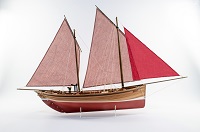 |





